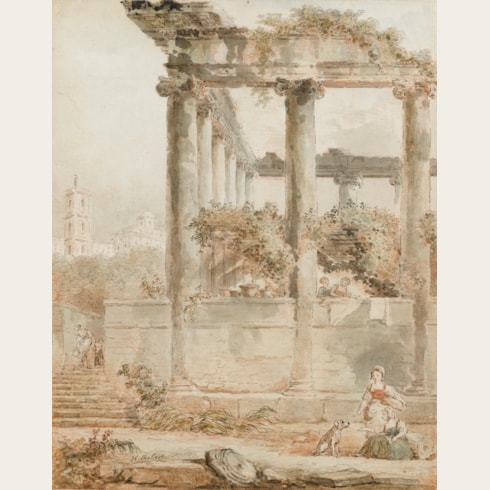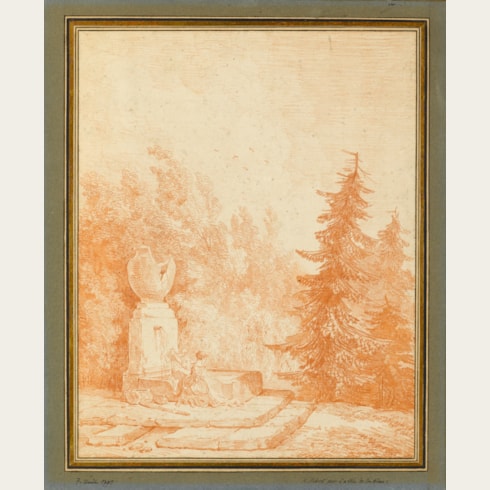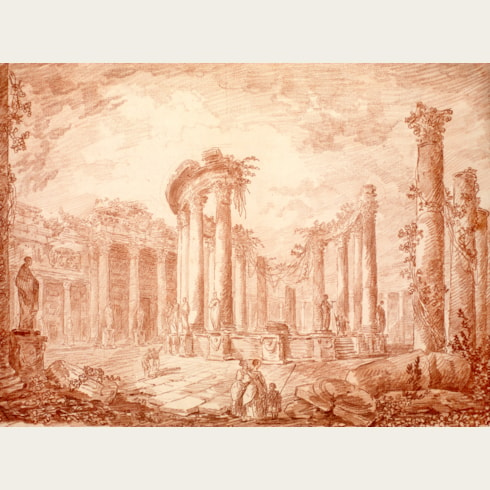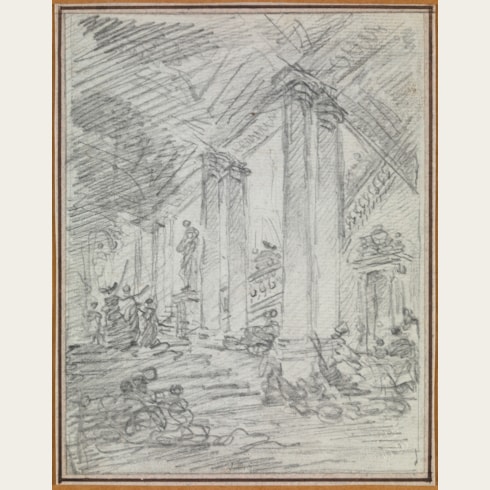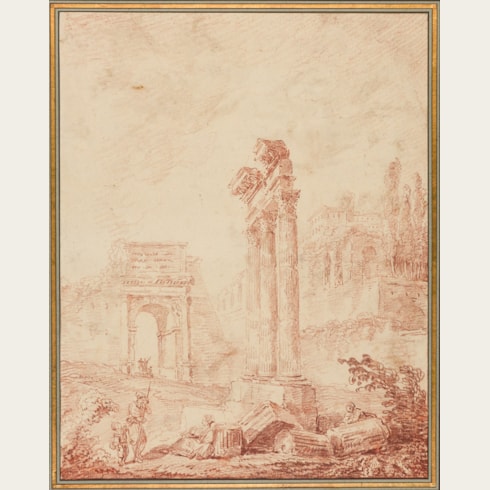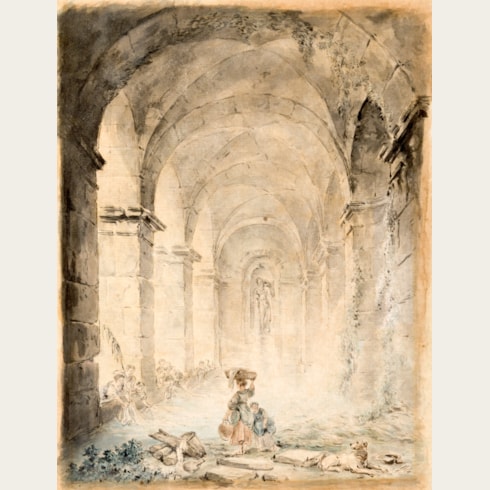Hubert ROBERT
(Paris 1733 - Paris 1808)
Laundresses at a Fountain: Design for a Frontispiece
Signed Robert. at the lower centre.
Inscribed FRAGMENTS / VENISE in brown ink, over black ink, in the centre.
Numbered 133. in pencil at the upper right centre.
136 x 190 mm. (5 3/8 x 7 1/2 in.)
A slightly larger variant of this composition, with added touches of watercolour and different lettering, is in the Louvre. The Louvre drawing served as the frontispiece of an album, now disbound, of thirty-nine drawings of Roman views by Robert entitled 'Ensemble de vues variées dessinées à Rome par H. Robert 17…'. While the precise date of the album is unknown, it has been dated to c.1764-1765, during the artist’s last years in Rome.
The present sheet was later engraved by the Abbé de Saint-Non for the title page of the 'Quatrième Suite - Venise' of his 'Fragments choisies dans les Peintures et les Tableaux les plus intéressans des Palais et Églises de l’Italie', published in 1774. This was part of a series of nine suitesof prints after copy drawings by Fragonard and Robert, which Saint-Non compiled as the 'Recueil de Griffonis De Vues, Paysages, fragments antiques et Sujets Historiques, gravés tant à l'eau-forte et qu'au lavis par Mr. l'abbé de Saint-Non...d'après différent Maîtres des Ecoles Italiennes et de l'Ecole française', and published in two editions in c.1780 and c.1790.
The provenance of the present sheet includes three notable French collectors of 18th century drawings. The drawing was part of a significant group of over three hundred 18th century French and English drawings – including works by François Boucher, Jean-Honoré Fragonard, Hubert Robert, Gabriel de Saint-Aubin and Jean-Antoine Watteau – which were sold from the collection of the collector and antiquaire Alfred II Beurdeley (1847-1919) at auction in Paris in 1905.
This drawing was probably acquired at the 1905 Beurdeley sale by the eminent expert and auctioneer Marius Paulme (1863-1928), who assembled a highly significant collection of 18th century French drawings that was dispersed at auction after his death. The present sheet, however, was probably bought by Paulme for the eminent collector Georges Dormeuil (1856-1939). Advised by Paulme, Dormeuil wo began assembling paintings, drawings and works of art around 1890, and was active at many of the major auctions held in Paris between 1895 and 1922. His collection of paintings and drawings displayed a particular focus on works of the 18th century, and included several works by artists such as Boucher, Cochin, Fragonard, Greuze, Huet, Leprince, Perronneau, Robert, Saint-Aubin and Watteau, among many others. He also collected drawings by a handful of French artists of the 17th century, notably Dumonstier and Lagneau. In 1934 he presented several important objets d’art to the Louvre, as well as three drawings by Gabriel de Saint-Aubin to the Musée Carnavalet in Paris.
A student of the sculptor Michel-Ange Slodtz, Hubert Robert travelled to Rome in 1754 in the retinue of the new French ambassador to the Vatican, the future Duc de Choiseul. It was probably through the influence of Choiseul that, although he was not officially a pensionnaire at the Académie de France in Rome, the young Robert was able to study there for several years. Succinctly described by the director of the Académie de France, Charles-Joseph Natoire, as a young man ‘who has a penchant for painting architecture’ (‘qui a du goût pour peindre l’architecture’), Robert spent a total of eleven years in Italy, mostly in Rome. He fell under the particular influence of Giovanni Paolo Panini, the leading Italian painter of architectural views and capricci, who taught perspective at the Académie de France. Robert’s earliest paintings and drawings, both in composition and technique, are greatly indebted to the example of Panini. At the Académie de France Robert met and befriended Jean-Honoré Fragonard, and with him made sketching tours of the countryside around Rome.
Robert returned to Paris in 1765, and the following year was admitted into the Académie Royale as a ‘peintre des ruines’, rather unusually being both reçu and agrée in the same year. He made his debut at the Salon in 1767, exhibiting picturesque landscapes and capricci, and soon had developed such a reputation for paintings of real and imagined Roman views, often incorporating ancient ruins, that he was given the sobriquet ‘Robert des Ruines’. A versatile artist, Robert often repeated and developed favourite views or compositions in several different formats, including chalk drawings, finished watercolours, small cabinet pictures and large-scale wall paintings. Appointed dessinateur des jardins du roi in 1778, Robert was also able to incorporate his artistic ideas into his landscape designs for gardens at Versailles and elsewhere. Despite being imprisoned during the Revolution, he remained a significant figure in the artistic scene in Paris until the end of the century.
Provenance
His sale, Paris, Galerie Georges Petit, 13-15 March 1905, lot 207 (‘Un frontispiece pour le voyage de l’abbé de Saint-Nom. (4esuite Venise). Un escalier de pierre conduit à une terrasse d’où une fontaine en forme de lion jaillit dans un bassin. Plusieurs femmes et des laveuses animent la composition. Dessin au lavis de sepia. Signé à la plume. Haut., 13 cent.; larg., 19 cent.’)
Marius Paulme, Paris
Georges Dormeuil, Paris (Lugt 1146a)
Thence by descent.
Literature






